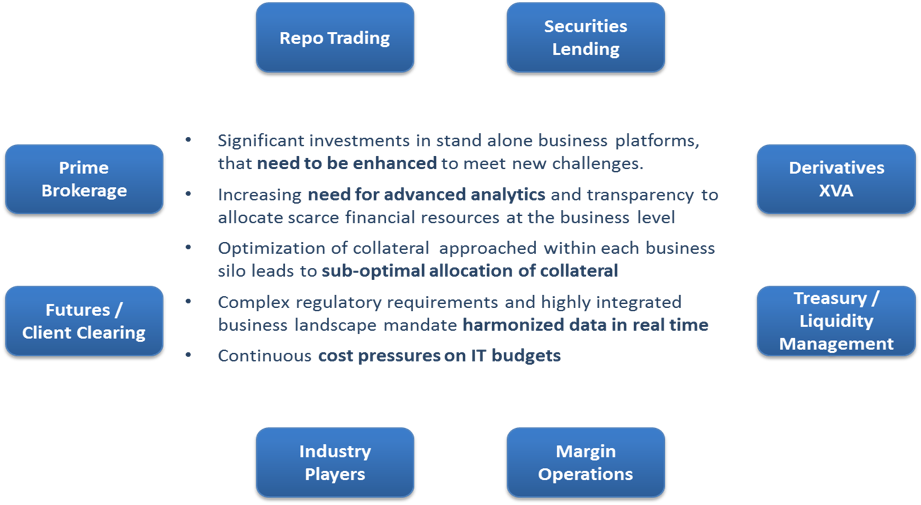Building a Holistic Collateral Infrastructure
- Jul 28, 2017
- Blog Collateral Management Securities Finance
Following the financial crisis, regulations and their associated reporting have created an opportunity for banks and investment firms to create a single, unified collateral infrastructure across all product siloes. This does not have to be a radical architecture rebuild, but rather can be achieved incrementally.
There are legitimate historical reasons why collateral infrastructure has grown up as a patchwork of systems and processes. For products such as stock lending, repo, futures or contracts for difference (CFDs), the collateral/margining process was generally integral to the products and processing systems. It would not have made sense to break out collateral management into a separate group and hence operating teams and systems were structured around the core product unit. Generally, only OTC derivatives had a relatively clear decoupling between collateral management and other operational processes. Even as business units merged at the top level, this product separation at the collateral management level often continued.
While this situation could stand during non-stress periods, the financial crisis demonstrated the fallacy that siloed, uncoordinated collateral management systems, data and processes could weather any storm. This disjointed view caused a number of specific problems, including: an inability to see the full exposures to counterparties; a lack of organization in cash and non-cash holdings; and substantial inflexibility in mobilizing the overall collateral pool. Even before the crisis, inconsistent or “zero cost allocation” for collateral usage meant that collateral was not always being directed to the parts of the business that needed it most. After the crisis, with collateral and High Quality Liquid Assets at a premium, this became unacceptable.
Today, few banks and investment firms have completed the work of integrating their collateral management functions across products (see Exhibit 1). Some of the largest banks are focused on building capabilities to achieve enterprise-wide collateral optimization, while others are just starting on this effort, at least on a silo basis. Some have bought or built large systems with cross-product support, although this has proven costly. Others are evaluating organizational consolidation. Whatever their current state, a new round of regulatory reporting requirements in the US and Europe means that letting collateral infrastructure sit to one side is no longer viable to meet business or compliance objectives without adding substantial staff. One way or another, long-term solutions must be achieved.
Exhibit 1: Moving past the siloed approach


Source: Transcend Street Solutions
The next round of regulatory impact
While nearly all large firms have digested the current waves of regulatory reporting and collateral management requirements, the next round will soon be arriving. Among these are the Federal Reserve’s regulation SR14-1, MiFID II (Revision of the Markets in Financial Instruments Directive), and the Securities Finance Transactions Regulation (SFTR). It is worth looking at some of these requirements in detail to understand what else is being demanded of collateral management infrastructure and departments.
The Federal Reserve’s regulation SR14-1 is aimed at improving the resolution process for US bank holding companies. It includes a high level requirement that banks should have effective processes for managing, identifying, and valuing collateral it receives from and posts to external parties and affiliates.[1] At the close of any business day banks should be able to identify exactly where any counterparty collateral is held, document all netting and rehypothecation arrangements and track inter-entity collateral related to inter-entity credit risk. On a quarterly basis they need to review CSAs, differences in collateral requirements and processes between jurisdictions, and forecast changes in collateral requirements. Also on the theme of improved resolution rules are the record keeping requirements related to “Qualified Financial Contracts” (effectively most non-cleared OTC transactions).[2] These require banks to identify the details and conditions of the master agreements and CSAs applying to the relevant trades.
While the regulatory intent is understandable, these requirements are exceptionally difficult to meet without a unified collateral infrastructure. There is in fact no way to respond without a single, holistic view of collateral and exposure across the enterprise. While SR14-1 impacts only the largest banks, it still means these banks have a mandate to complete the work they have begun in organizing their vast collection of collateral information. This will lead to greater collateral opportunities for the big banks, and may in turn encourage smaller competitors to complete the same work in order to exploit similar new efficiencies.
Article 15 of Europe’s SFTR places restrictions on the reuse of collateral (rehypothecation). The provider of collateral has to be informed in writing of the risk and consequences of their collateral being reused. They also have to provide prior, express consent to the reuse of their collateral. Even with the appropriate documentation and reporting in place, a collateral management department has to carefully ensure that the written agreement on reuse is strictly complied with. While nothing is written in the US yet, market participants believe that the US Office of Financial Research will soon require mandatory reporting that may entail overlapping requirements.
Similarly, MiFID II introduces strict restrictions on the use of customer assets for collateral purposes and potentially has a major impact on collateralized trading products. A complicated analysis must be conducted on best execution, but in OTC and securities financing markets, best execution may be a function of term, price, counterparty risk and/or collateral acceptance. Further, any variation from a standard best price policy needs to be documented to show how the investment firm or intermediary sought to safeguard the interest of the client.
SFTR and MiFID II require that banks rethink their entire reporting methodologies, and in some cases must rethink parts of their business model. A wide range of new information must be captured, analyzed, consolidated, and reported outwards and internally. This will likely generate new ideas and business opportunities around collateral usage and pricing for those firms that can digest the large quantities of new information that will be produced.
A holistic foundation for trading, control, MIS and regulatory reporting
The struggle at many firms to comply with regulations while maximizing profitability has led to two parallel sets of infrastructures: one for the business and another for compliance. This creates two levels of cost that duplicate substantial effort inside the firm. Along the way, business lines get charged twice for this work as costs are allocated back to the business. This is an immediate negative impact on profitability; even firms that have completed collateral optimization immediately lose a piece of that financial benefit.
The cumulative impact of regulation means that banks and investment firms generally cannot afford to wait for consolidation projects to deliver a single integrated platform. The fragmentation of teams, data and processes are hurdles for any institution to overcome but so is the old mindset that simply thinks of collateral management as an isolated operational process.
We identify five critical areas for firms to address in order to create a foundation for their holistic collateral infrastructure:
- Map the full impacts of regulatory and profitability requirements on businesses, processes, and systems.
- Recognize that collateral management is an integral part of many key activities at the firm including trading and liquidity management.
- Understand the core decision making processes at the heart of effective collateral management.
- Organize and manage the data that is required to drive those processes.
- Build a functional operating model for collateral management.
The fifth recommendation, building a functional operational model for collateral, means being able to connect together disparate business lines to provide an enterprise view of collateral. It includes mining collateral agreements to make optimal decisions or decisions mandated by regulation. It requires the ability to perform analysis of collateral to balance economic and regulatory drivers, and it requires controls and transparency of client collateral across all margin centers.
At Transcend Street Solutions, we are actively working with our clients to help them develop a strategic roadmap of business and technology deliverables to achieve a holistic collateral infrastructure. While there are always organizational as well as infrastructural nuances in every business, we have seen the framework proposed above yield a positive return for our clients. Our technology platform, CoSMOS, is nimble, modular and customizable to accelerate collateral infrastructure evolution without necessarily having to retire existing systems or undergo a big infrastructural lift.
Getting this right is important for more than just regulatory compliance. It means the collateral function and trading desks can perform the forward processes required to support both profitable trading and firm-wide decision making. Pre-trade analytics is needed to ensure that collateral is allocated optimally across portfolios and collateral agreements. Optimization is also needed at the trade level to ensure the most suitable collateral is applied to each trade or structure. Finally, analysis needs to be carried out across the whole inventory of securities and cash positions to ensure collateral is used by the right businesses. After all, correct pricing of collateral across business lines is not only essential for firm-level profitability but also incentivizing desirable behavior throughout the organization.
We strongly believe that firms that are successful in achieving a holistic collateral architecture will have a significant competitive advantage in the industry. They will be able to achieve optimization of collateral and liquidity across business silos while meeting most global regulatory requirements, and all that with a much more efficient IT spend.
This article was originally published on Securities Finance Monitor.





